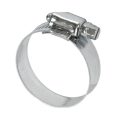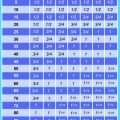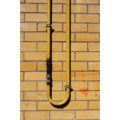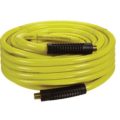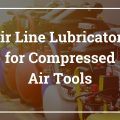Hey! This site is reader-supported and we earn commissions if you purchase products from retailers after clicking on a link from our site.
When it comes to connecting parts of your air system together, along with the appropriate fittings, you have the choice of using an air hose or air tube and now you must wonder what considerations you must take.
Choosing the best air hose for your compressor system can be a challenging process. This page will provide you with guidelines to ensure you make an informative decision on buying the right air hose that is reliable and efficient for your pneumatic applications.
Table of Contents
- Choosing the Right Air Hose
- How to Measure Air Hose Size?
- Air Hose Pressure Drop
- Fittings For Compressor Hose
- Compressed Air Tube
- Products Available on Amazon
- Selecting Your Air Hose- Your Options
- FAQs (Frequently Asked Questions)
Choosing the Right Air Hose
You may think that choosing the right air hose is a reasonably straightforward decision, well it’s not. Though it is essentially an accessory that gets air from your air compressor (point A) to the pneumatic tool (point B), there is certainly more to it than just that.
You must consider a number of factors like length, inside diameter, work environment, tools, and budget. Let’s break this down into the four most important considerations:
- What size air hose do I need? – Length
- What size air hose do I need? – Internal Diameter
- Do I require a standard or recoil hose?
- What material hose should I use?
Now let us take a look at these in greater detail! Another important consideration would be the material of the air hose, we have a separate page focused on providing you with all the relevant information on this here.
What Size Air Hose Do I Need? – Length
The length of the hose is an important consideration as it can directly have an impact on the performance of your air tools. Of course, you could purchase a 50m long hose that would certainly reach all your requirements but is that really necessary? Probably not!
The longer the length of your air hose the greater the amount of air pressure drop will be, and this is certainly avoidable. You should think carefully about what you’ll be using your air tools for and how much movement you require in your space.
If you have a large garage space or workshop and you require access to your compressed air at numerous locations around the space, you’ll of course need a greater length hose than someone who’s only going to need compressed air at their workbench.
A greater length of hose may provide you with the benefit of not needing to use an extension cord, however, you must consider whether the CFM requirement of your tool in use is similar to the output of your compressor – why? If that’s the case then every little bit of air counts so a shorter hose will help minimize any pressure losses.
I mentioned the use of an extension cord and although it is not recommended to use one, please visit our what size extension cord for an air compressor guide for more information on selecting one if you must.
I would advise if you need to extend your air compressor reach to a further distance that you use a longer hose rather than an extension cord due to the burnout risks associated with extension cords.
Common Air Hose Sizes
- 5ft
- 10ft
- 15ft
- 25ft
- 50ft
- 100ft
The majority of standard air hoses will come complete with male NPT fittings on both ends of the hose. To use the hose, you will add a connector to the thread on one end, and a coupler to the thread on the other. This creates an “air extension cord” which can be used to bring air to an air tool from the compressor discharge coupler.
If you have two or more air hoses with couplers and connectors installed on them, you can connect one hose to the other, extending your air hose length almost indefinitely allowing you to potentially reach any distance.
Note: connecting hoses together will provide additional pressure drops at each coupler.
What Size Air Hose Do I Need? – Internal Diameter
Hoses are generally sized by their internal diameter. The larger the internal diameter of the hose, the more air it will be able to carry and this can also help reduce frictional losses similar to the use of shorter-length hoses.
Common Air Hose Diameter
- 1/4″
- 3/8″
- 1/2″
- 3/4″
- 1″
When you are trying to figure out what hose size you need, or even why a 3/4″ hose is well over an inch in diameter, just remember the acronym H.I.D. The ‘H’ in H.I.D. stands for HOSE. The ‘I.D.” in HID stands for the hose “inner diameter”.
A 3/8″ hose will have a hole in the center that is exactly 3/8″ in diameter regardless of how the outer diameter of the hose varies. And it does, depending on the type of hose and the manufacturer.
So, will all same size air hoses have the same outer diameter (O.D.)? Nope, they won’t.
Different manufacturers offer air hoses with varying wall thicknesses. Therefore, one 3/8″ hose might be just under 1″ in outer diameter, and another might be a 1 1/4″ outer diameter, yet in both cases the internal diameter will still be 3/8″, identifying them as a 3/8″ hose.
It is often the higher-priced hose that has a larger outside diameter due to more mass in the wall thickness or integrating reinforcement into the hose wall for greater burst strength.
A good rule of thumb to abide by when selecting your internal diameter is that the higher the CFM requirement of your air tool, the larger the diameter you will need. Tools that only require say 1-3 CFM will work perfectly with a 1/4″ hose.
The diameter will affect the overall weight of the hose significantly, as a couple of mm will add up over the entire length!
Do I Require A Standard or Recoil Hose?
This is mostly a decision of preference. Standard air hoses lie flat and do not contain bends or coils, but can be wrapped into loops for storage. They are commonly mounted in a hose reel that can be wound up with a handle like your common garden hoses.
The alternative, a recoil hose, has lots of small twits with tensile memory similar to telephone wires. When you let go of the hose it shrinks back into position for easy storage.
This will typically depend upon your application, recoil hoses are suitable so that they can spring out of your way however if you’re doing spray painting their resistance may become annoying so you would prefer a standard hose.
What Material Hose Should I Use?
| Material | Advantages | Disadvantages |
|---|---|---|
| Rubber | – Heavy (doesn’t kink) – Flexible – Good in varying temperatures | – Fairly high cost |
| PVC | – Cheap – Light | – Can kink but not a great deal – Bad in cold weather |
| Polyurethane | – A lighter version of rubber – Good for working on the move | – Kinks a lot – Quite expensive – Bad for heavy-duty work |
| Nylon | – Lightest option – Can be coiled up easily – Great for moving around | – Kinks easily – Short lifespan |
| Hybrid | Aims to combine the best of PVC and Rubber |
The material you choose for your air hose can have a significant effect on your flexibility, weight, and certainly its performance.
You must consider all these four decisions in conjunction with one another to find the most suitable air hose for your applications.
How to Measure Air Hose Size?
To measure air hose size you will need to use a ruler, vernier, or tape measure, then you can simply measure the inside diameter of the hose as shown in the YouTube demonstration above.
Air Hose Pressure Drop
Air pressure drops as the air moves through a hose. The longer the hose, the greater the pressure drop. Pressure drop is a concern for your air-driven equipment. It might be worth your time to review our page on how pressure drop affects your air tool use.
Pressure drop is unavoidable, however, you can take a few steps to minimize it:
- Run a shorter hose if possible
- Minimize the use of fittings and accessories
It’s better to ramp up the pressure and enlarge the air hose diameter and length to run the air tool effectively than to run a too-long extension cord to the portable compressor and possibly burn out the compressor motor. You can always use a regulator next to the tool if this is the case, to step down the pressure.
Fittings For Compressor Hose
Most air hoses will come ready-fitted with a type of end fitting that you can use to connect your air compressor and tools. You can learn about all the various types of air compressor tools here! These fittings used are typically barbed-style hose fittings.
Barbed style hose fittings will have a barbed profile on one side and a “quick connect” – a coupler or connector – on the other side.
The barb will be a specific fractional size, and that is the size that will correspond to the internal diameter of the hose.
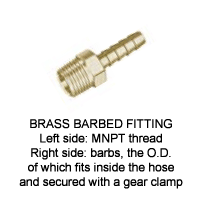
A specific barbed fitting will only fit a certain size of hose inside diameter. So you would purchase a 3/8″ barbed fitting to fit inside the I.D. of a 3/8″ hose, for example. Visit our air hose fittings types guide for more information!
Installing Barbed Fittings On a Compressor Hose
First, you slide a gear clamp over the hose, then insert the fitting barb into the hose inside diameter. Some folks use a little soap to make this easier. If I find that the barb is tight, generally I just use some good ‘ol spit!
Once the barb is inside the hose, slide the gear clamp back up the hose until it’s well over the barb inserted inside the hose, and then tighten securely.
On the other side of the barbed fitting could be another barb, a coupler, a connector, or a male or female thread. You acquire the barbed fitting that suits your air hose installation requirements. They’re seemingly available in all variations.
Having durable and reliable fittings is essential in the efficient and safe use of air tools!
Compressed Air Tube
A compressed air tube is an inexpensive and quick-to-install compressed air supply line suitable for almost any compressed air application. What’s the difference between air tube and air hose?
The key difference between compressed air tubing and air hose is how the size of each is measured. Tubing is specified by outside diameter— for its compatibility with push-to-connect fittings. An air hose is specified by its inner diameter and is typically sold with swivel, rigid, or quick-disconnect fittings attached at both of its ends.
Sizing Air Tube For Compressed Air Lines
When Measuring Tube Size – remember TOD. The ‘T’ in TOD stands for TUBE.
The O.D. in the acronym TOD stands for outer or outside diameter.
So, you measure the compressed air tube by its outer dimension, not the hole in the middle.
A 1/4″ poly tube (the compressed air industry workhorse airline) will be exactly 1/4″ on the O.D.
Want to check? If you take a 3/8″ hose and then you take a piece of 3/8″ P.E. (polyethylene) tube, the 3/8″ P.E. tube will slide inside the 3/8″ hose perfectly. The same for 1/4″ tube into 1/4″ hose, 1/2″ tube into 1/2″ hose, etc.
Air Tube Applications
The vast majority of airlines used in the industry are polyethylene or polyurethane tube. Polyethylene is the most common as it is the least expensive, easily obtained, usually purchased in 100-foot rolls, is easily cut, and quickly attached to an instant type fitting.
If you are contemplating doing a lot of compressed air plumbing, talk to your supplier. You can purchase compressed air tubes in 1000′ plus rolls if you need that much.
I would not normally use a hard poly air tube to supply an air tool. The fittings used for poly tubes do not lend themselves to any kind of sideloading with a hard or rigid tube.
An air tool is in constant motion, and in moving an air tool to do work, you would be sideloading the tube-to-fitting connection all the time. It might not be too long before the connection failed or started to leak.
The hard poly tube does not take to bending in a too-tight coil. The right poly tube for an air tool is the “coil hose” type which is designed to stretch as the tool is being used and has fittings suitable for the side loading using an air tool commonly imparts to the connection. You can learn more about industrial piping materials here.
Connecting Air Tube
As mentioned earlier, you normally use poly tubes with instant-type fittings, however, sometimes mini-barbed type fittings are used as well.
Instant Fittings
The instant fitting, into which you insert a square-cut end of the poly tube, has some type of “O” rings inside it. The “O” ring seals on the outside of the tube to render the tube-to-fitting connection airtight.
This is why an accurate O.D. is critical for the tube. Once I blamed a vendor for a batch of fittings that I thought were out of specification. Further investigation revealed that a whole lot of poly tube was undersized by a couple of thousandths of an inch. That was enough to allow continuous leaking in the tube-fo-fitting connection, and even allowed “blow off” of the tube from the fitting periodically.
Inside the tube orifice of the instant fitting, there will also be a ring with teeth and a collet. When the tube is inserted, these teeth penetrate the surface of the tube lightly to hold the tube in the fitting.
When compressed air is introduced to the polyline, it expands the poly tube slightly, and the teeth grip even harder preventing the airline blow out.
Mini-Barb Fittings
The mini-barb is just as it sounds. One side has a barb that is sized to fit inside the tube. The other side has a fitting to connect to the boss. When using a mini-barb on tubing, typically hose clamps are not used. The “sticktion” inside from the barb to the tube is normally sufficient to keep the barb inside the tubing.
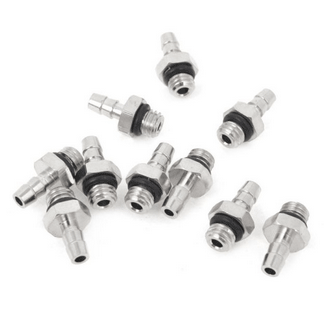
Air Tube Considerations
The use of an instant fitting then requires a certain surface hardness of the tube to work properly.
Airline tubing that is quite soft or stretches easily may be better installed with a fitting specifically for them.
Since with a softer tube the tube O.D. will actually lessen as the tube is stretched for the application, or in dynamic equipment, the stretching may reduce the O.D. of the tube sufficiently for blow-off to happen.
Since you measure the tube on the O.D. then the mating connecting hole on the fitting must be the same size as the tube. A 1/4″ tube will have an actual 1/4″ mating-size hole in the fitting. Over recent years, the “instant” style fitting has become the predominant style of fitting to connect airlines in the 10-32 through the 1/2″ tube size.
Products Available on Amazon
I have picked out a couple of standard and recoil hoses that could meet your requirements. Please ensure you buy the correct air compressor hose size inside diameter to fit your air compressor with a suitable length.
Standard Hoses Available on Amazon
The first is a standalone 3/8″ 50ft hose will male threadings on either end. This hose has a maximum working pressure of 300 PSI and offers great flexibility.
- EXTREMELY FLEXIBLE - All weather flexibility (-40° to 140°F)
Prices pulled from the Amazon Product Advertising API on:
Product prices and availability are accurate as of the date/time indicated and are subject to change. Any price and availability information displayed on [relevant Amazon Site(s), as applicable] at the time of purchase will apply to the purchase of this product.
The second standard hose is a compressor kit containing a 3/8″ 25 FT air compressor hose size, which comes with all the relevant fittings including adapters, connectors, blow gun, tire chuck, and more.
- Includes 3/8” x 25 ft air tool hose and another 18 pieces essential air compressor parts
Prices pulled from the Amazon Product Advertising API on:
Product prices and availability are accurate as of the date/time indicated and are subject to change. Any price and availability information displayed on [relevant Amazon Site(s), as applicable] at the time of purchase will apply to the purchase of this product.
Recoil Hoses Available on Amazon
The first recoil hose is a 1/4″ 25ft long flexible with weather that comes with quick fittings and bend restrictors.
- POLYURETHANE CONSTRUCTION: No tangles, anti kinking, abrasion resistance, durable and light weight.
Prices pulled from the Amazon Product Advertising API on:
Product prices and availability are accurate as of the date/time indicated and are subject to change. Any price and availability information displayed on [relevant Amazon Site(s), as applicable] at the time of purchase will apply to the purchase of this product.
The second is a 1/4″ 25ft long 18-piece accessory kit that comes with all your suitable fittings, connectors, and additional attachments.
- ➤ Advanced Air Compressor Tool Kit – This 18-piece compressor accessory set includes a long 25ft recoil poly air hose, high flow blow gun, high flow nozzle, 360° swivel connector, ball chuck, couplers, inflation needles, pencil tire pressure gauge and more.
Prices pulled from the Amazon Product Advertising API on:
Product prices and availability are accurate as of the date/time indicated and are subject to change. Any price and availability information displayed on [relevant Amazon Site(s), as applicable] at the time of purchase will apply to the purchase of this product.
Selecting Your Air Hose- Your Options
I have picked out this YouTube video which describes the various hose options you have, their strengths and their weaknesses from the guys over at Compressor Source – worth a watch!
FAQs (Frequently Asked Questions)
A good rule of thumb is the higher the CFM requirement of your air tools, the greater the size internal diameter hose you should use to handle the airflow. The internal diameter of your air hose will typically be either 1/4″ or 3/8″. The length depends upon how far you intend to use your air tools away from your air compressor, keeping in mind that the greater the length of the hose, the greater the pressure drop.
Depending on your needs, most people go for a recoil hose as they shrink back into position for easy storage. They can, however, become difficult when spray painting for instance so if this is your desired application then a standard hose would be better suited to you.
Air compressor hoses are somewhat universal in their use in that they connect air compressors and air tools. However, some pneumatic tools may require specific couplings and certain applications will require certain hoses.
Typically air compressor hoses will be anything up to around 100ft. This is a popular length so that people can maximize their application distance from the air compressor. It is unlikely you would need anything longer than this and though you may be able to find 150ft or 200ft hoses, their use is not recommended due to the pressure drop.
Additional Reading:
- Using Aluminum Air Pipe For Compressed Air
- Copper Pipe For Compressed Air
- Galvanized vs Black Pipe
- Using ABS Pipe For Compressed Air
- Using Nylon Tubing For Compressed Air
- PVC Air Lines
- Using Pex Pipe for Compressed Air Lines
- Best Compressed Air Pipeline Material
- Steel vs Brass Air Fittings
- Industrial vs Automotive Air Fittings
- Compressed Air Metric Fittings
- Air Hose Fittings Types
- Compressed Air Fittings Guide
- Using Pex-Al-Pex Compressed Air & Pex-Al-Pex Fittings
- Pex A vs Pex B Pipe & Fittings
- PEX Fitting Types
- How to Plumb an Air Compressor Setup in Garage
If you have any questions about air hose sizes and any buying considerations, please leave a comment below, with a photo if applicable, so that someone can help you!




